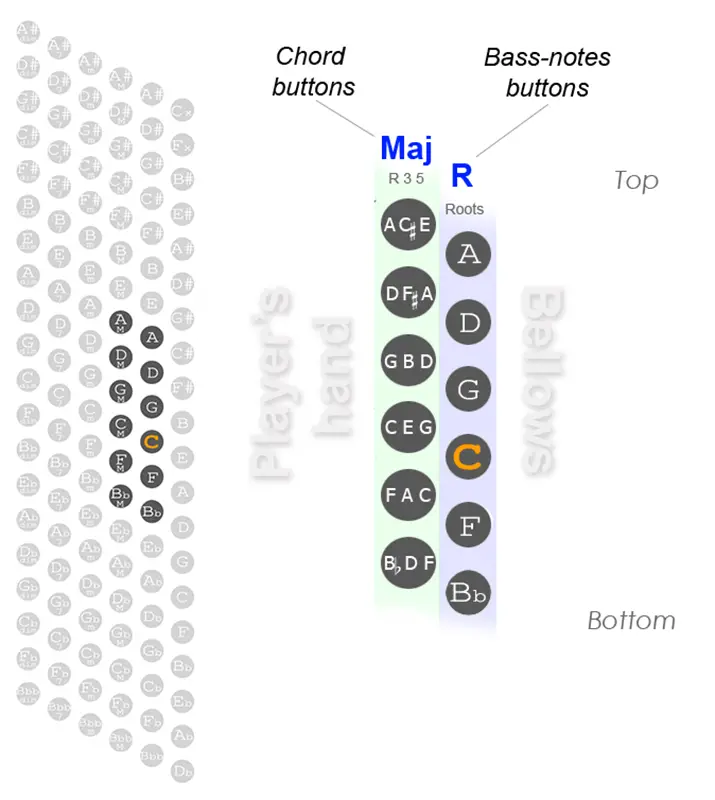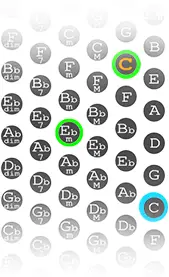The 12 bass accordion is a beginner’s model which makes it an excellent choice for any child to begin on. It has 1 column of single bass notes, 1 column of chords, and 6 rows. Since the left-hand buttons are minimal, it’s easy to get familiar with the Stradella bass system and learn how to play major chords. The repertoire associated with this kind of accordion is rather small due to the lack of root notes on the left side and only consists of simple successions and combinations of major triads, however, note that a 12 bass accordion can play also 3 minor 7th chords. The 6 missing keys are (F#/Gb), B, E, (Eb/D#), (Ab/G#), (Db/C#). It has no counter basses, no minor, no 7th, nor diminished chords.
If you are totally new to the Stradella bass system, read this article.
12 Bass Accordion Layout

All chords you can play on a 12 Bass Accordion
The number of chords you can play on a 12 bass accordion is quite limited. There are only 6 Major chords in the keys of A, D, G, C, F, and Bb, however, combining chords and roots you can get:
- 3 minor 7th chords
- 4 Dominant 9th/11th chords
- 4 Dominant 9th sus4 chords
- 5 Major 7th/9th chords
How to read the lists of chords
Here are some guidelines to help you read the following lists of chords and charts:
- Flats and sharps are paired with their enharmonic equivalent chord, for example, C#Maj7 = DbMaj7
- Chords that can be played are clickable and are colored in blue, for example, DMaj
- Chords that can’t be played are colored in gray and are crossed out by a horizontal line, for example,
Bdim7. - Duplicated chords are colored in light blue, for example, E#m7 = Fm7

- Some chords can be played in two different ways: by combining a chord with a bass note or by combining a chord with a counter-bass button. For this reason, you’ll find two lists for the same group of chords, one for those that can be played combining a counter bass with a chord (“On Counter Bass” list) and one for those chords that can be played combining a bass note (“On Root” list).
- The charts of those extended chords that can be built combining a chord with a counter bass or with a bass note, show both positions: counter basses are circled in blue, and basses are circled in green.
Standard chords
6 Major chords
Major chords are built with a Root (R), a major third (3rd), and a perfect fifth (5th).
On a 12 bass accordion you can play these Major chords:
F#Maj = GbMajBMajEMaj- AMaj
- DMaj
- GMaj
- CMaj
- FMaj
- BbMaj = A#Maj
EbMaj = D#MajAbMaj = G#MajDbMaj = C#Maj
Combined Chords
3 minor 7th chords
A minor 7th chord is a minor chord with a minor 7th added.
It is built with a Root (R), a minor third (m3rd), a perfect fifth (5th), and a minor seventh (m7th).
On the Stradella bass system, you can play a minor 7th chord by combining a Root with the Major chord built on its minor 3rd interval, for example, C + EbMaj = Cm7.
On a 12 bass accordion you can play these minor 7th chords:
4 Dominant 11th chords
The Dominant 11th chord is a dominant 7th chord with a major 9th (same as a 2nd) and an 11th (same as a 4th) added.
It is built with a Root (R), a major third (3rd), a perfect fifth (5th), a minor 7th (m7th), a major ninth (9th), and an eleventh (11th).
On the accordion, you can play a Dominant 11th chord by combining a Root and its major chord with the major chord built on its minor 7th interval, for example, C + CMaj + BbMaj = C11.
The 11th interval is dissonant in major and dominant chords because the 11th and the major 3rd are adjacent tones.
For example, C11 = C, E, G, Bb, D, F.
On a 12 bass accordion you can play these Dominant 11th chords:
4 Dominant 9th sus4 chords
Dominant seventh ninth suspended chords (9sus4) consist of a Root (R), no third, a perfect fourth (4th), no fifth, a minor seventh (m7th), and a ninth (9th) note of the major scale built on the root.
Stradella bass system allows you to play 9sus4 chords on the accordion combining the root bass with the major chord of its minor 7th degree, for example, C + BbMaj = C9sus4
On a 12 bass accordion you can play these Dominant 9th sus4 chords:
F#9sus4 = Gb9sus4B9sus4E9sus4- A9sus4
- D9sus4
- G9sus4
- C9sus4
F9sus4Bb9sus4 = A#9sus4Eb9sus4= D#9sus4Ab9sus4 = G#9sus4Db9sus4 = C#9sus4
5 Major 7th/9th chords
The Major 7th/9th chord (Maj7/9) is a Major 7th chord with a major 9th added.
It is built with a Root (R), a major third (3rd), a perfect fifth (5th), a major seventh (7th), and a major ninth (9th).
On the accordion, you can play a Major 7th/9th chord by combining a Root and its Major chord with the Major chord built on the 5th interval from the Root, for example, C + CMaj + GMaj = CMaj7/9.
On a 12 bass accordion you can play these Major 7th/9th chords:

I just bought a 25 piano key 12 bass accordion and i plan on teaching myself so I need all the help I can get.
Hi Judy,
thank you for reaching out. Congratulations on your new accordion!
Teaching yourself can be a rewarding journey. On accordionchords.com, you’ll find a wealth of resources to help you along the way, including chord charts, tutorials, and tips for beginners. Feel free to explore the site, and don’t hesitate to reach out if you have any specific questions or need assistance.
Happy playing!